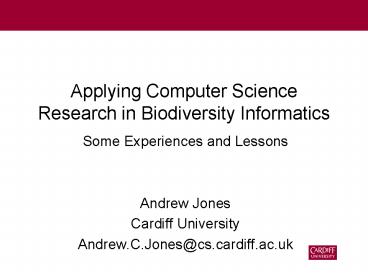Applying Computer Science Research in Biodiversity Informatics PowerPoint PPT Presentation
1 / 18
Title: Applying Computer Science Research in Biodiversity Informatics
1
Applying Computer Science Research in
Biodiversity Informatics
- Some Experiences and Lessons
- Andrew Jones
- Cardiff University
- Andrew.C.Jones_at_cs.cardiff.ac.uk
2
Example predicting effect of climate change
- Typical question Where might a species be
expected to occur, under present or predicted
climatic conditions? - Some relevant resource types
- Data sources
- Catalogue of life
- Species Information Sources (SISs)
- Species geography
- Descriptive data
- Specimen distribution
- Geographical
- Boundaries of geographical political units
- Climate surfaces
- Genetic sequences
- Analytic tools
- Biodiversity richness assessment various
metrics - Bioclimatic modelling bioclimatic envelope
generation - Phylogenetic analysis (generation of phylogenetic
trees)
3
Some potential problems
- Availability of data
- Originally constructed for various reasons
proprietary standards no interoperability - Even if on Internet, may be difficult to find or
use - Heterogeneity
- Representation
- Granularity
- Scientific naming issues
- Flexibility scalability
4
LITCHI background
- BBSRC/EPSRC- and EU- funded
- Aim to detect conflicts between species
checklists and either - Assist in producing a consistent checklist, or
- Generate correspondences between checklists
(cross-map) - Addressed problems presented by species
classification and naming variations when
accessing data relating to species
5
LITCHI example
- Checklist 1
- Caragana arborescens Lam. (accepted name)
- Caragana sibirica Medikus (synonym)
- Checklist 2
- Caragana sibirica Medikus (accepted name)
- Caragana arborescens Lam. (synonym)
- (Lam. Lamark)
A full name which is not a pro-parte name may
not appear as both an accepted name and a synonym
in the same checklist
6
Issues in LITCHI
- Used constraints (implemented in Prolog) on what
constituted a consistent checklist - Repair standard techniques for integrity repair
fail to generate some important possible ways of
repairing violations - Our approach to add information that allows us
to distinguish between categories of constraint
violation - Sicstus Prolog/Visual Basic/Microsoft Access
solution only worked on some PCs(!) - So we reimplemented in Java
7
SPICE for Species 2000
- Initial project funded by BBSRC/EPSRC follow-on
by EU - The SPICE for Species 2000 project aimed to
- build a federated catalogue of scientific names
organised by taxon (species, etc.) - accommodate GSD (Global Species Database)
heterogeneity, autonomy instability - ensure scalability
- Addressed availability of dataheterogeneity of
representation
8
SPICE internal architecture
9
Implementing SPICE
- Techniques have included
- Common Data Model
- Tightly coupled federation
- Small set of supported request types (canned
queries) - CORBA and HTTP (CGI)/XML implementations
- Issues
- Trade-off between scalability and ease of
deployment - CORBA
- Scaled up well
- Useful platform for CAS load balancing
- Firewall problems heavyweight, unfamiliar
technique for GSD providers - HTTP/XML
- Less scalable
- Easily deployed(Some providers simply had to
modify their existing Webfront end code)
10
GRAB (GRid And Biodiversity)
- 6 month DTI-funded demonstrator project
- Project aim
- Assess Grids potential for collaborative
research in biodiversity informatics - Supporting discovery use of diverse
biodiversity-related databases - Exploring use of Globus SRB middleware
11
(No Transcript)
12
GRAB resource types
Catalogueof life
SIS
Climate
SIS
...
GRAB resource clients
GRAB interface
- Catalogue of life
- Scientific common names
- Species Information System (SIS)
- Images geography
- Climate
- Max/min temperature annual precipitation
13
Issues in GRAB
- Problems installing Globus research software
- Essentially wanted to send distributed requests
receive responses - Initial HTTP-based prototype worked well
- Versions of SRB then available had little to
offer - Globus 2 approach needed canned queries,
temporary files, etc much more difficult than
the HTTP prototype
14
The BiodiversityWorld project
- 3 year e-Science project funded by BBSRC
- Aim
- Build a Biodiversity Grid(Problem Solving
Environment to support Biodiversity research)
15
BiodiversityWorld architecture
User interface
Presentation
Workflow
enactment
Wrapped
Native
engine
resources
Biodiversity
-
Metadata
World
repositor
y
Resources
BGI API
BiodiversityWorld
-
GRID
Interface
(BGI)
The GRID
16
Issues in BDW
- Globus 3 provides Grid Services, but still
evolving (WSRF in Globus 4) - Trade-off abstraction layer (BGI) including
invocation mechanism - Insulates from change
- Wraps resources to remove needless heterogeneity
- Wraps the wrapped resources (!) to insulate from
infrastructure change - Performance penalty
- Assume computationally intensive applications lie
in a single BDW resource - Hinders interoperation with other
Grid/Webservices
17
Summary
- We have applied
- modern, complex commercial software
- specialised research software, and
- Computer Science theory
- to address biodiversity informatics problems
- In practice, real-world applications often
bring limitations in such software techniques
to light, necessitating (e.g.) compromises,
trade-offs, work-arounds, extensions to theory,
18
Acknowledgements
- UK DTI, EPSRC BBSRC EU
- Collaborators on grants mentioned Universities
of Southampton and Reading Natural History
Museum (London) - Organisations that have co-operated with these
research projects, especially - Species 2000
- ILDIS
- FishBase
- Hadley Centre for Climate Prediction and Research

